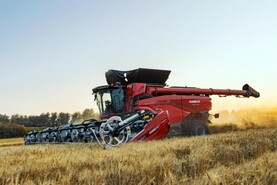This time of the year is when I have to decide if I accept or reject the offer to sell forward some of my harvest. I don’t have much discretion as my gluten-free oats is tied to the wheat prices. The oilseed rape and beans seem to have little forward activity while my seed wheat is directly related to the 1 November post-harvest price.
Nevertheless, I was conscious I had missed the offer of €162/t (green) that was available in mid-February. Since then, I had seen the price drift slowly but continuously down so when €152/t was offered last week, I decided to forward sell a proportion of my winter barley. Maybe it will turn out to have been the wrong decision – as it would have this time last year, but the years have been different. The other crucial decision for this time of the year is how much insurance spraying of the crops is justified?
There is quite a bit of yield potential, but I am reluctant to go into what is a tall crop of oilseed rape with an insurance spray to counteract a possible attack by weevils. I would have to hire in a high-clearance machine and I am acutely conscious that our neighbour has almost 20 hives of bees around the place and I am loathe to put them at risk or ask him to close the hives without a very good reason. So, my inclination is to leave the crop until it is time to desiccate pre-harvest which is now only about six to eight weeks away.
Meanwhile, on the cattle side, the extraordinary conditions in February meant an exceptional amount of early grazing took place, so we are closing up ground that has been grazed twice, so our silage is going to be later than the ideal. On the other hand, we have saved on meal through giving zero-grazed grass to the finishing bulls. If everyone else in the country has done the same, I am not surprised at the reports of leftover grain from last year’s harvest, especially with such quantities of imported maize.
Read more
Grain prices: output forecasts pile more pressure on wheat
2019-20 global grain harvest heading for 2,178m tonnes
This time of the year is when I have to decide if I accept or reject the offer to sell forward some of my harvest. I don’t have much discretion as my gluten-free oats is tied to the wheat prices. The oilseed rape and beans seem to have little forward activity while my seed wheat is directly related to the 1 November post-harvest price.
Nevertheless, I was conscious I had missed the offer of €162/t (green) that was available in mid-February. Since then, I had seen the price drift slowly but continuously down so when €152/t was offered last week, I decided to forward sell a proportion of my winter barley. Maybe it will turn out to have been the wrong decision – as it would have this time last year, but the years have been different. The other crucial decision for this time of the year is how much insurance spraying of the crops is justified?
There is quite a bit of yield potential, but I am reluctant to go into what is a tall crop of oilseed rape with an insurance spray to counteract a possible attack by weevils. I would have to hire in a high-clearance machine and I am acutely conscious that our neighbour has almost 20 hives of bees around the place and I am loathe to put them at risk or ask him to close the hives without a very good reason. So, my inclination is to leave the crop until it is time to desiccate pre-harvest which is now only about six to eight weeks away.
Meanwhile, on the cattle side, the extraordinary conditions in February meant an exceptional amount of early grazing took place, so we are closing up ground that has been grazed twice, so our silage is going to be later than the ideal. On the other hand, we have saved on meal through giving zero-grazed grass to the finishing bulls. If everyone else in the country has done the same, I am not surprised at the reports of leftover grain from last year’s harvest, especially with such quantities of imported maize.
Read more
Grain prices: output forecasts pile more pressure on wheat
2019-20 global grain harvest heading for 2,178m tonnes






 This is a subscriber-only article
This is a subscriber-only article









SHARING OPTIONS: